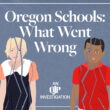Sean C. Morgan
Twenty-three years ago, a young Oregon Jamboree hadn’t reached regular profitability, and an equally young Sweet Home Economic Development Group found itself constantly pre-occupied by the Jamboree.
It had established the Jamboree as a fund-raising tool for local economic development projects, and soon it was receiving requests for funding. To cope, the SHEDG Board of Directors conceived the idea of a foundation and set about the task of starting one and transferring proceeds from the Jamboree to the foundation.
The Sweet Home Community Foundation officially celebrates its 20th anniversary this year. Its endowment started with $1,000. In the following years, when the Jamboree became regularly profitable, SHEDG transferred 10 percent of its profits to the foundation.
Since 2009, the Jamboree hasn’t reported a profitable year. But since then, it has been holding annual fund-raising events – backyard barbecues and auctions with Jamboree artists – during the Jamboree to benefit the foundation.
Last year, the Jamboree’s fund-raising program drew in $4,000 for the foundation, said former Mayor Tim McQueary, one of the foundation’s founders. Additionally, the Safeway Foundation presented the foundation with a $5,000 check, as it has done for several years, during the Jamboree Kickoff Party.
The foundation itself has collected donations, the largest more than $200,000, and with a recent $18,000 transfer, its endowment has climbed to more than $500,000.
McQueary and retired Police Chief Bob Burford both served on the SHEDG Board of Directors during the foundation’s planning stages, and both began serving as members, Burford as president, of the foundation’s initial Board of Directors.
“I was serving on the SHEDG Board when we founded the Ore-gon Jamboree,” McQueary said. “The Oregon Jamboree was going to be revenue conduit for economic development in the Sweet Home area.”
It provided the promise of money coming into the Sweet Home community, he said, but the SHEDG board was busy running the Jamboree and looking into a permanent site for the Jamboree.
With people looking for cash assistance from SHEDG, McQueary said, “it was too much for them to take care of.”
The board decided to form a 501(c)3, which allows tax-deductible donations, McQueary said. The Sweet Home Community Foundation was the result.
“There was a recognition that at some point, there would be an opportunity for seeking grant funds to bring resources into the community,” Burford said, and SHEDG board members believed that the foundation would be the perfect mechanism to hold the land if SHEDG found a permanent site for the Jamboree.
“Looking into the future, nobody knew what the Jamboree was going to do, how it would develop,” Burford said.
Even during the years when the foundation received Jamboree revenue, SHEDG and the foundation were looking toward the future.
“We recognized that the Jamboree wasn’t going to be around forever,” Burford said. “It was important to build the endowment.”
“We’ve been putting money away because the object is to establish a permanent endowment and live off the earnings,” McQueary said.
Today, most of the foundation’s income is from donations, Burford said. Benefactors can have donations deducted directly from their paychecks if an employer sets it up. Both the Sweet Home School District and the City of Sweet Home are set up for employees to donate.
The foundation also raises funds through a fall giving campaign each year, Burford said.
The largest donation, $202,000, established the Alice Blazer Endowment.
Even while donations, fund-raising efforts and investments grow the endowment, the foundation’s Board of Directors believe that simultaneously giving back to the community is important, Burford said. As a result, some donations are granted to community organizations annually.
April 6, the foundation presented a total $12,343 in grant funds to seven community organizations.
“There are organizations around the Sweet Home community that need the shot in the arm because what they do is worthwhile,” McQueary said.
These are the organizations that do needed work in the community, Burford said.
“If we help them financially, then we’ve been a success.”
The foundation may receive and hold donations in different ways, allowing donors to help direct how funds are used and to be remembered.
Donations may be given to the foundation’s General Discretionary Fund. Those funds are used to provide grants to Sweet Home area organizations that provide services in the foundation’s focused areas, its “Community Building Blocks,” which includes children and families, livability, arts and culture and education.
Donations also may be directed toward a specific Community Building Block.
On donations of at least $5,000, a provision may be added for the Community Foundation to seek advice from the donor or persons named by the donor for distribution from the fund.
The advice is not binding on the foundation, but the advice is given full and careful attention, Burford said.
On donations of at least $5,000, a provision may be added to name one or more charitable organizations to be assisted by the fund. Should the charitable organization cease to exist or its purpose become obsolete, the foundation can redirect the distributions to similar charitable purposes.
“Leave a Local Legacy” is a new program creating a named personal endowment fund, Burford said.
“We’ve just put that in place, toward the fall of last year.
“These funds assure that future generations will know of an individual’s or family’s generosity and foresight for our community’s future,” he said. The program has a $20,000 threshold. The endowment may be established over a five-year period.
“It can be directed to one of our Community Building Blocks, or it can just be in general.”
The program functions similarly to the Alice Blazer Endowment Fund, Burford said.
“Setting up the Alice Blazer Fund was the impetus to push this through,” McQueary said. The foundation looked at other legacy programs to develop the parameters for its program.
So many families in Sweet Home have helped and still constantly help out wherever the community has a need, Burford said. This program can allow that help to be remembered.
“Whether in memory of a patriarch or a matriarch, they can name it,” Burford said. “Each year, those grants will be attributed to that endowment.”
Charitable organizations may also transfer all or part of their endowment funds to the Community Foundation to participate in the foundation’s larger investment programs.
Called fiscal sponsorship, starting with the recent Husky Field turf project, the Community Foundation began helping ad hoc groups by providing a nonprofit, tax-deductible way to collect and hold donations, Burford said. In those situations, it may not be reasonable for the group, with a single project or goal, to go through the nonprofit process.
If the project aligns with the foundation’s Community Building Blocks, the foundation can hold the funds. Most recently, it began holding funds for the Sweet Home Auditorium Remodel Committee, which is attempting to update, repair and upgrade the Sweet Home High School Auditorium and performing arts equipment.
“Our goal has been and continues to be to get the permanent endowment to the million dollar level,” Burford said.
“This can go on in perpetuity,” McQueary said. “We want to get to the point where we can fund larger projects.”
Right now, the largest grants are $2,500, Burford said. The foundation can consider $5,000 in special circumstances. They would like to increase those numbers to $5,000 and $10,000.
At $1 million, a 5-percent return on investment is $50,000, McQueary said.
Money is primarily invested and managed through the Oregon Community Foundation, which has an excellent track record, Burford said. “They have professional money managers.”
While Burford and McQueary personally want to be involved in reaching the million-dollar mark, they are conscious of the future and want to ensure that dedicated individuals are involved in the board long-term.
The Board of Directors averages eight to 10 individuals, Burford said. The board can include up to 15.
“We’re always looking for people who would like to help out and be involved in philanthropy,” Burford said. They like the board to represent a variety of backgrounds. The board depends on its members
‘ expertise. The broader the board’s experiences, the more information it may have to evaluate projects and make decisions.
McQueary and Burford plan to continue their involvement.
Although his position as police chief was paid, his role was to serve the community, Burford said. That continues to be his motivation.
His children grew up and graduated from school in Sweet Home, he said.
“This community has been great to us. We have a lot of dedicated people here trying to do good work, and if I can, I want to be part of that.”
McQueary said he has been involved in the community since the early 1990s. He served on the Oregon Community Foundation’s Leadership Council. He served on the Sweet Home Alumni Foundation Board of Directors and the Service Board under the Cascades West Council of Governments. He was a City Council member and mayor. He has served on the SHEDG board, and he enjoys his continued involvement in the foundation.
“It has a very, very high value to the community,” McQueary said. “Getting it to where it can operate in perpetuity will pay rewards for people coming along. It’s a give back for me.”
For more information about the Sweet Home Community Foundation and its mission or to donate, visit its website, sweethomecommunityfoundation.org, call (541) 730-3670 or email [email protected].
The foundation is also set up to receive donations from the Amazon Smile program. When purchasing products from Amazon, log in through smile.amazon.com, and Amazon will donate .5 percent of the sale to the foundation.




